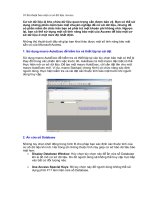Bài giảng Bảo mật cơ sở dữ liệu: Security models - Trần Thị Kim Chi
Bạn đang xem bản rút gọn của tài liệu. Xem và tải ngay bản đầy đủ của tài liệu tại đây (1.81 MB, 141 trang )
SECURITY MODELS
Operating System Security Fundamentals
Tiếp theo bài 1 bắt đầu từ Slide 10
Giảng Viên: Trần Thị Kim Chi
© FPT Software
1
Agenda
a. Access control
b. Inference and covert channels
c. Open/close policy
d. Database Application Security Models
Discretionary/mandatory access control
© FPT Software
2
Access control
•
Access control is a security technique that can be used to regulate who or what can
view or use resources in a computing environment.
•
Access control systems perform authorization identification, authentication, access
approval, and accountability of entities through login credentials includingpasswords
, personal identification numbers (PINs), biometric scans, and physical or electronic
keys.
© FPT Software
3
Types of Access control
•
There are two main types of access control:
–
–
•
Physical,
logical.
Physical access control limits access to campuses, buildings, rooms and physical IT
assets.
•
Logical access limits connections to computer networks, system files and data.
© FPT Software
4
Types of Access control
The four main categories of access control are:
ã
ã
ã
ã
Mandatory access control
Discretionary access control
Role-based access control
Rule-based access control
â FPT Software
5
Mandatory access control (MAC)
•
Mandatory access control (MAC) is a system-controlled policy restricting access to
resource objects (such as data files, devices, systems, etc.) based on the level of
authorization or clearance of the accessing entity, be it person, process, or device.
ã
/>
â FPT Software
6
Discretionary access control (DAC)
•
Discretionary
access
control (DAC)
is
a
type
of access control defined
by
the
Trusted Computer System Evaluation Criteria "as a means of restricting access to objects based
on the identity of subjects and/or groups to which they belong. The controls are discretionary in
the sense that a subject with a certain access permission is capable of passing that permission
(perhaps indirectly) on to any other subject (unless restrained by mandatory access control)".
•
Discretionary access control is commonly discussed in contrast to mandatory access control
(MAC, sometimes termed non-discretionary access control).
© FPT Software
7
Role-based access control (RBAC)
•
Role-based access control (RBAC) is a method of regulating access to computer or network
resources based on the roles of individual users within an enterprise...
ã
ã
/>http://
searchsecurity.techtarget.com/tip/Role-based-access-control-for-effective-security-management
â FPT Software
8
Rules Based Access Control
•
Rules Based Access Control is a strategy for managing user access to one or more systems,
where business changes trigger the application of Rules, which specify access changes.
•
Implementation of Rules Based Access Control systems is feasible so long as the number of
triggering business events and the set of possible actions that follow those events are both small.
•
- See more at: />
© FPT Software
9
Authentication Methods
•
Authentication:
–
–
•
Permits access to the operating system
Physical authentication:
–
–
•
Verifies user identity
Allows physical entrance to company property
Magnetic cards and biometric measures
Digital authentication: verifies user identity by digital means
© FPT Software
10
Authentication Methods
•
•
Digital certificates: digital passport that identifies and verifies holder of certificate
Digital token (security token):
–
–
–
Small electronic device
Displays a number unique to the token holder; used with the holder’s PIN as a password
Uses a different password each time
© FPT Software
11
Authentication Methods
•
Digital card:
–
–
–
•
Also known as a security card or smart card
Similar to a credit card; uses an electronic circuit instead of a magnetic strip
Stores user identification information
Kerberos:
–
–
Developed by MIT
Uses tickets for authentication purposes
© FPT Software
12
Authentication Methods
•
Lightweight Directory Access Protocol (LDAP):
–
–
Developed by the University of Michigan
A centralized directory database stores:
•
•
•
•
–
Users (user name and user ID)
Passwords
Internal telephone directory
Security keys
Efficient for reading but not suited for frequently changing information
© FPT Software
13
Authentication Methods
•
NTLM:
–
–
•
Developed and used by Microsoft
Employs a challenge/response authentication protocol
Public Key Infrastructure (PKI):
–
–
–
User keeps a private key
Authentication firm holds a public key
Encrypt and decrypt data using both keys
© FPT Software
14
Authentication Methods
•
•
RADIUS: used by network devices to provide a centralized authentication mechanism
Secure Socket Layer (SSL): authentication information is transmitted over the network in an
encrypted form
•
Secure Remote Password (SRP):
–
–
Password is not stored locally
Invulnerable to brute force or dictionary attacks
© FPT Software
15
Authorization
•
•
•
Process that decides whether users are permitted to perform the functions they request
Authorization is not performed until the user is authenticated
Deals with privileges and rights
© FPT Software
16
Operating System Authentication
•
Many databases (including Microsoft SQL Server
2000) depend on OS to authenticate users
•
Reasons:
–
Once an intruder is inside the OS, it is easier to access
the database
–
•
Centralize administration of users
Users must be authenticated at each level
© FPT Software
17
User Administration
•
•
•
•
Create user accounts
Set password policies
Grant privileges to users
Best practices:
–
–
–
–
Use a consistent naming convention
Always provide a password to an account and force the user to change it at the first logon
Protect passwords
Do not use default passwords
© FPT Software
18
Creating a SQL Server User
•
•
•
•
Create a login ID first; controls access to SQL Server system
Associate login ID with a database user
Must be member of fixed server roles (SYSADMIN or SECURITYADMIN)
Two types of login IDs:
–
–
Windows Integrated (trusted) login
SQL Server login
© FPT Software
19
Creating Windows Integrated Logins
•
Command line:
–
–
•
SP_GRANTLOGIN system stored procedure
Can be associated local, domain, group usernames
Enterprise Manager:
–
–
Use the Security container
Logins -> New Login
© FPT Software
20
Creating Windows Integrated Logins
© FPT Software
21
Creating SQL Server Logins
•
Command line:
–
–
–
•
SP_ADDLOGIN system stored procedure
Password is encrypted by default
Specify a default database
Enterprise Manager:
–
–
–
Security container
Logins -> New Login
SQL Server Authentication option
© FPT Software
22
Creating SQL Server Logins
•
Command line:
–
–
–
•
SP_ADDLOGIN system stored procedure
Password is encrypted by default
Specify a default database
Enterprise Manager:
–
–
–
Security container
Logins -> New Login
SQL Server Authentication option
© FPT Software
23
Removing Users
•
•
•
Simple process
Make a backup first
Obtain a written request (for auditing purposes)
© FPT Software
24
SQL Server: Removing Windows Integrated Logins
•
•
Command line: SP_DENYLOGIN system stored procedure
Enterprise Manager:
–
–
Highlight the desired login
Choose Delete from the Action menu
© FPT Software
25









